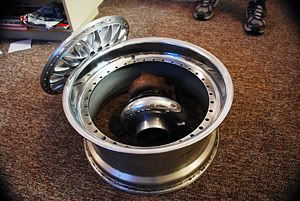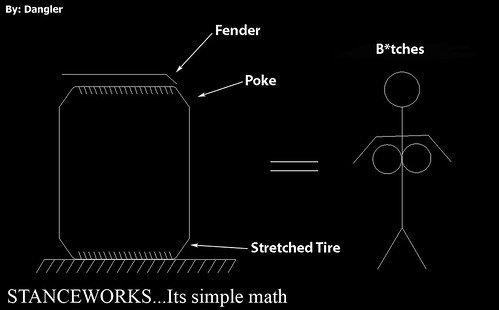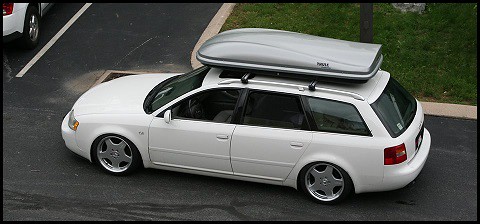Disclaimer: I am not in the tire manufacturing business, but this is the information I have gathered and researched.
In short, not on rolling diameters. I have seen people post up that stretched tires change the overall rolling diameter ("Look at the tire, the sidewall is a triangle now!! It must be taller!). That is incorrect. It does, however, change the Section Width.
I found some good information off Tire Rack that says [http://www.tirerack.com/tires/tirete...sectionwidth]:
Let's take an example of a common MK4 size and Tire: Falken Ziex 512 225/45/17

Here is how you calculate the OD (Outer Diameter, AKA: Rolling Diameter):
Width x Aspect Ratio = Section Height
Section Height x 2 = Combined Section Height
Combined Section Height + Wheel Diameter = Tire Diameter
225 x .45 = 101.25mm
101.25 x 2 = 202.5mm
202.5 + 431.8 (17x25.4) = 634.3mm / 25.4 = 24.97 inches
As you see from Falken, the 512 in 225/45/17 measures 25" total. That is a +/- .03" variance in the measurement.
However, they measured it from a 7.5" wide wheel with a section width of 8.8". What about if you put that on a stock LB/Monte that measures 7" wide? What about a wider wheel?
Let's see how that changes...
Note 225mm is 8.85 inches (225 / 25.4).
Wheel Width...Section Width Measurement
7"..................8.6"
7.5"...............8.8"
8"..................9.0"
8.5"...............9.2"
9"..................9.4"
9.5"...............9.6"
10"................9.8"
10.5".............10"
So, stretching tires, do increase the section width because you are widening the mounting point the tire beads are on, but the overall diameter, which most people are concerned about, does not have any (or any important/noticeable) change because it is maintained by the steel belts within the tire itself and you cannot add/remove physical material by stretching a tire.
PS: Remember that wheel widths are always measured from inside bead to inside bead. Overall widths are 1" wider (.5" bead on each side). So if you want to know what would "stretch" on a wheel, you need to account for the wheel beads so you can see if the tire will bubble over the beads or it would stretch.
In short, not on rolling diameters. I have seen people post up that stretched tires change the overall rolling diameter ("Look at the tire, the sidewall is a triangle now!! It must be taller!). That is incorrect. It does, however, change the Section Width.
I found some good information off Tire Rack that says [http://www.tirerack.com/tires/tirete...sectionwidth]:
Section Width
A tire's section width (also called "cross section width") is the measurement of the tire's width from its inner sidewall to its outer sidewall (excluding any protective ribs, decorations or raised letters) at the widest point. This measurement is made without any load placed upon the tire and after the tire has been properly mounted on its industry assigned measuring rim and has been inflated and reset to its test pressure after 24 hours.
Because a tire's section width is influenced by the width of the rim upon which the tire is mounted, the correct industry assigned measuring rim width for the tire size being measured must be used.
The width of a tire mounted on a narrow rim would be "narrower" than if the same tire was mounted on a wide rim. NOTE: because the overall diameter of a steel belted radial is determined by the steel belts, there is little, if any, change to the overall diameter of the tire due to differences in rim width.
The industry rule of thumb is that for every 1/2" change in rim width, the tire's section width will correspondingly change by approximately 2/10".
A tire's section width (also called "cross section width") is the measurement of the tire's width from its inner sidewall to its outer sidewall (excluding any protective ribs, decorations or raised letters) at the widest point. This measurement is made without any load placed upon the tire and after the tire has been properly mounted on its industry assigned measuring rim and has been inflated and reset to its test pressure after 24 hours.
Because a tire's section width is influenced by the width of the rim upon which the tire is mounted, the correct industry assigned measuring rim width for the tire size being measured must be used.
The width of a tire mounted on a narrow rim would be "narrower" than if the same tire was mounted on a wide rim. NOTE: because the overall diameter of a steel belted radial is determined by the steel belts, there is little, if any, change to the overall diameter of the tire due to differences in rim width.
The industry rule of thumb is that for every 1/2" change in rim width, the tire's section width will correspondingly change by approximately 2/10".

Here is how you calculate the OD (Outer Diameter, AKA: Rolling Diameter):
Width x Aspect Ratio = Section Height
Section Height x 2 = Combined Section Height
Combined Section Height + Wheel Diameter = Tire Diameter
225 x .45 = 101.25mm
101.25 x 2 = 202.5mm
202.5 + 431.8 (17x25.4) = 634.3mm / 25.4 = 24.97 inches
As you see from Falken, the 512 in 225/45/17 measures 25" total. That is a +/- .03" variance in the measurement.
However, they measured it from a 7.5" wide wheel with a section width of 8.8". What about if you put that on a stock LB/Monte that measures 7" wide? What about a wider wheel?
Let's see how that changes...
Note 225mm is 8.85 inches (225 / 25.4).
The industry rule of thumb is that for every 1/2" change in rim width, the tire's section width will correspondingly change by approximately 2/10".
7"..................8.6"
7.5"...............8.8"
8"..................9.0"
8.5"...............9.2"
9"..................9.4"
9.5"...............9.6"
10"................9.8"
10.5".............10"
So, stretching tires, do increase the section width because you are widening the mounting point the tire beads are on, but the overall diameter, which most people are concerned about, does not have any (or any important/noticeable) change because it is maintained by the steel belts within the tire itself and you cannot add/remove physical material by stretching a tire.
PS: Remember that wheel widths are always measured from inside bead to inside bead. Overall widths are 1" wider (.5" bead on each side). So if you want to know what would "stretch" on a wheel, you need to account for the wheel beads so you can see if the tire will bubble over the beads or it would stretch.















Comment